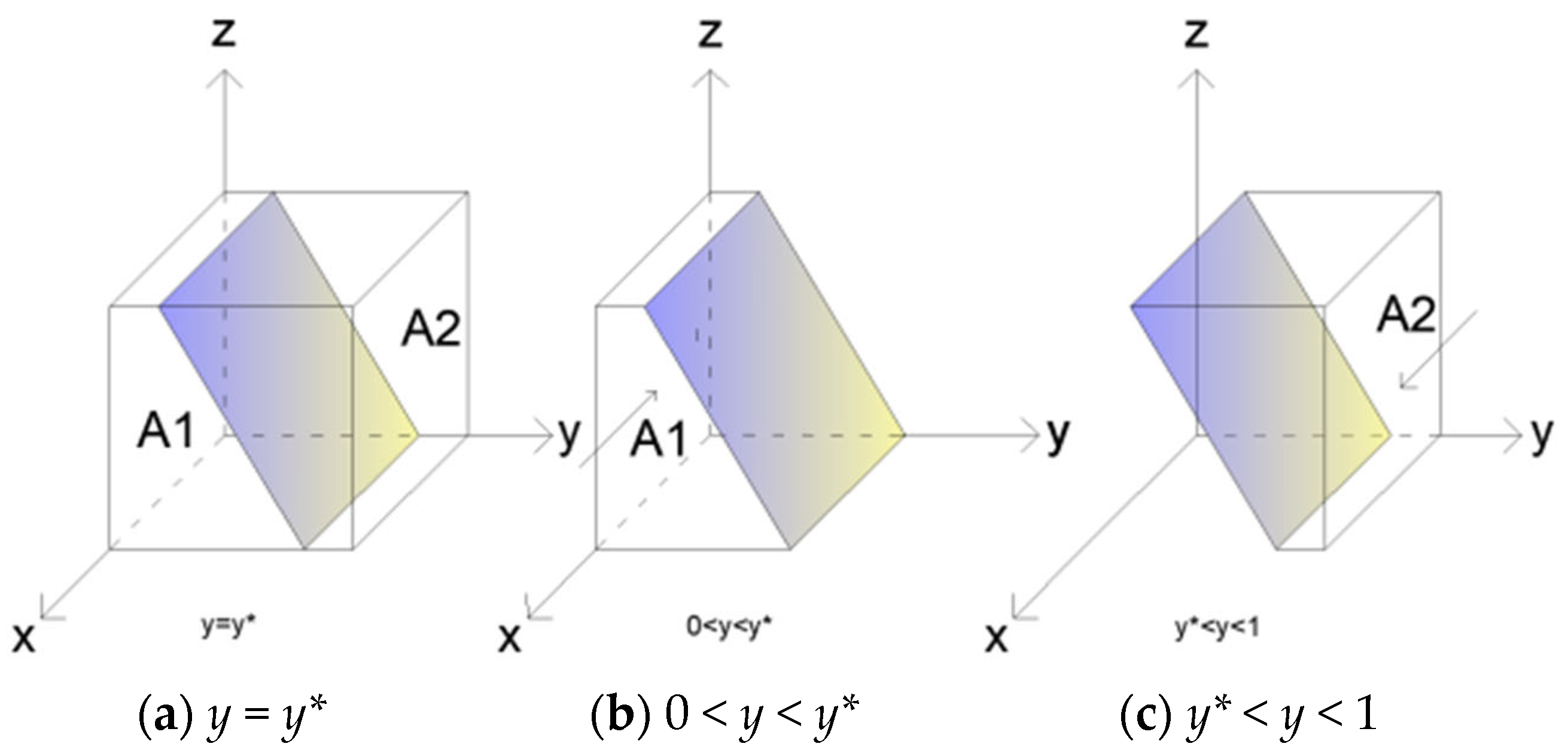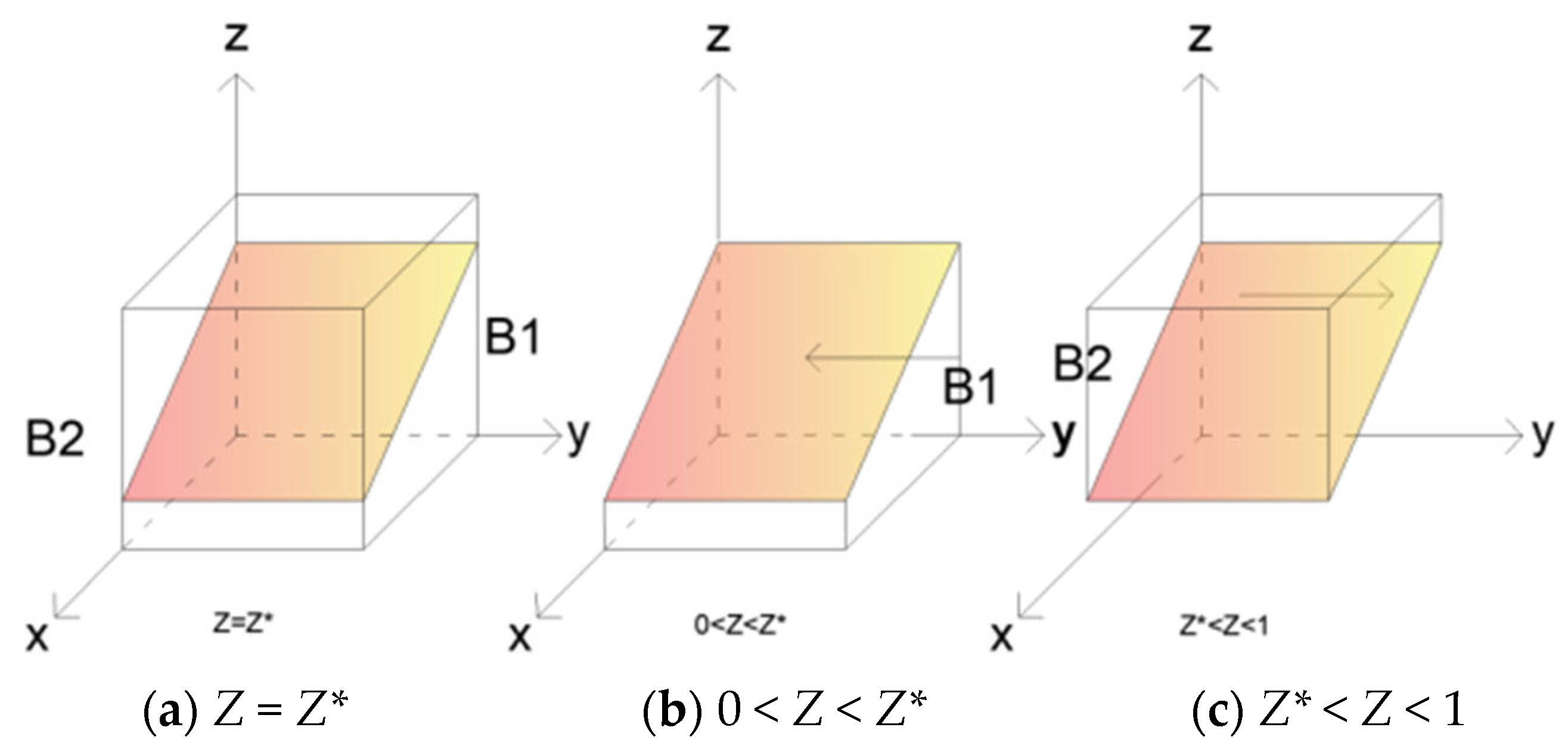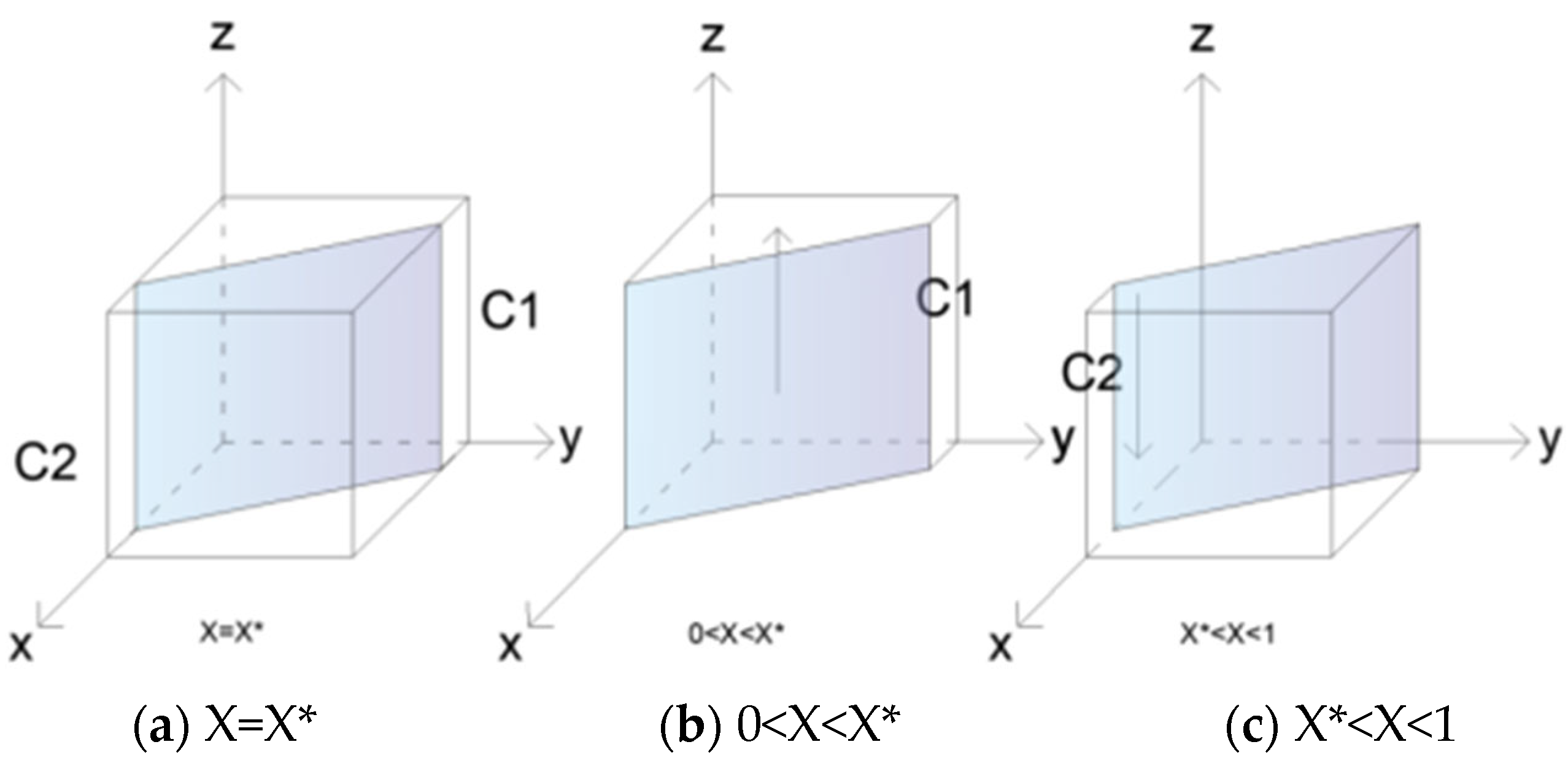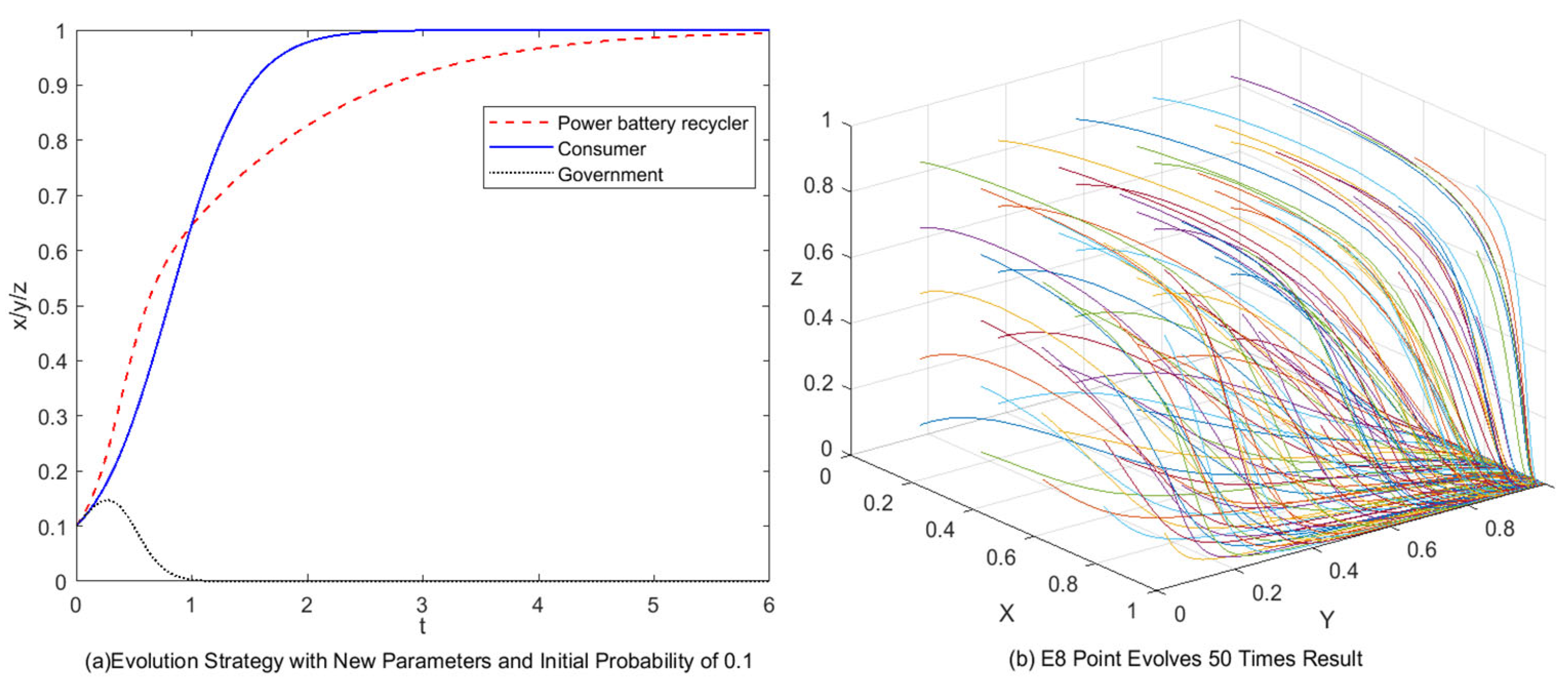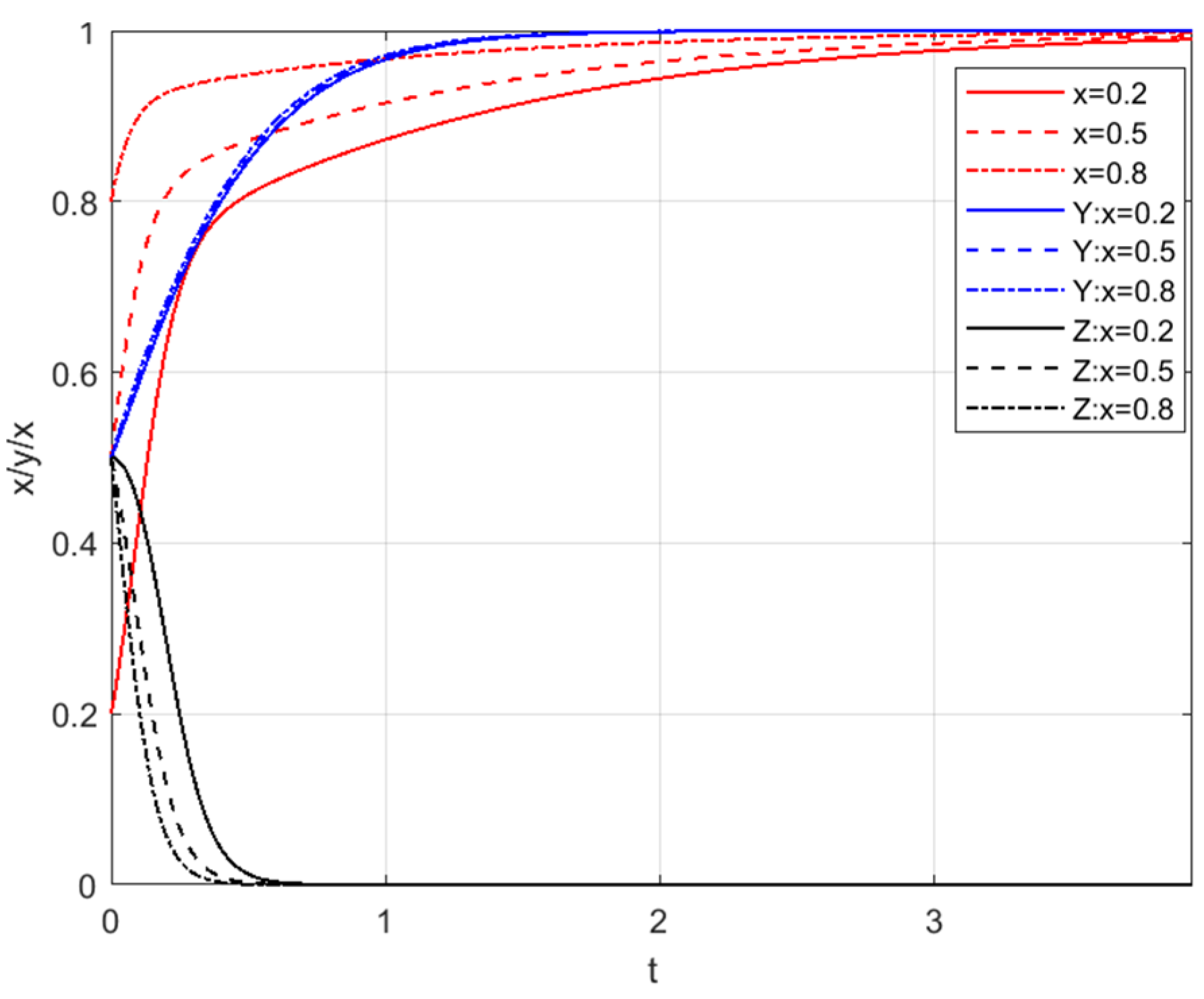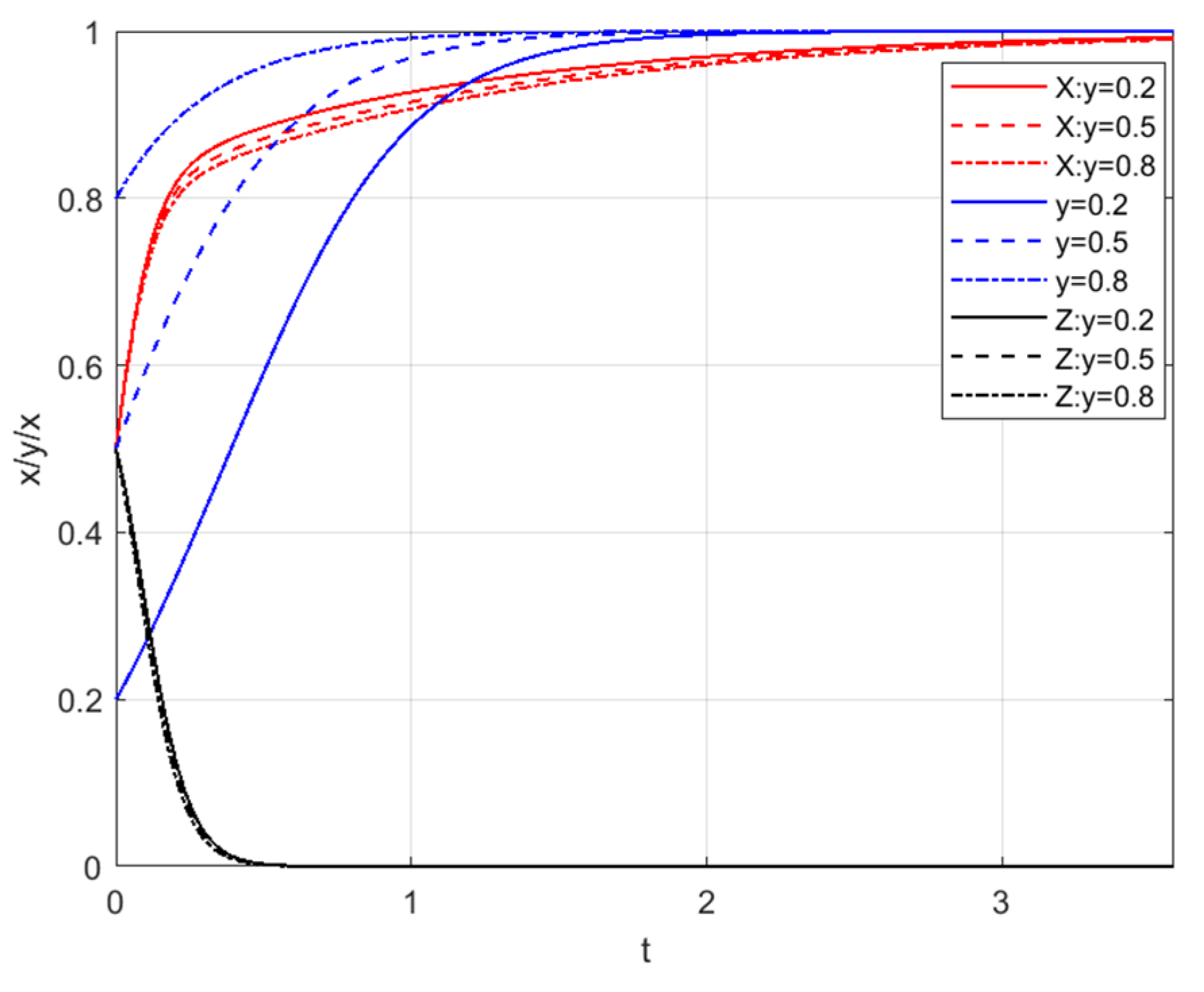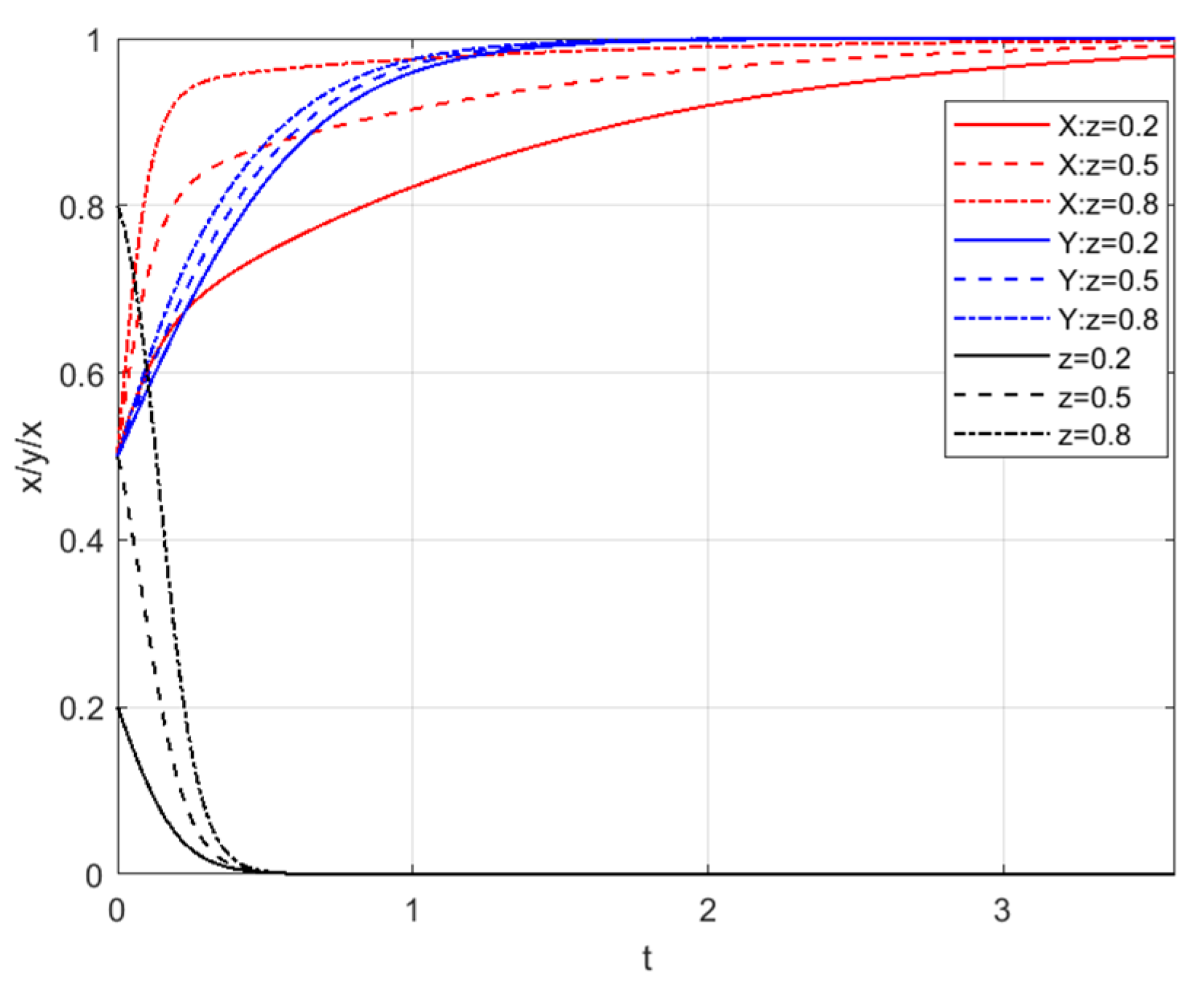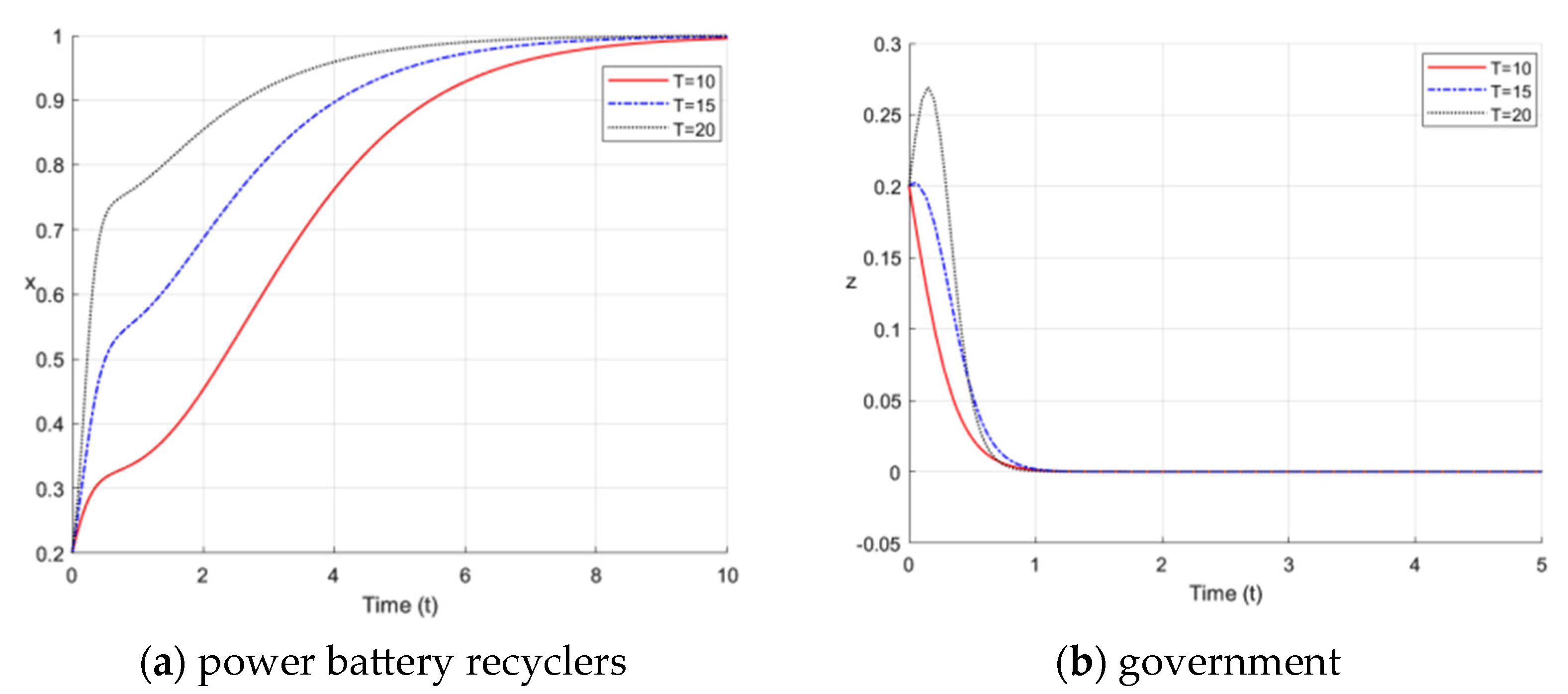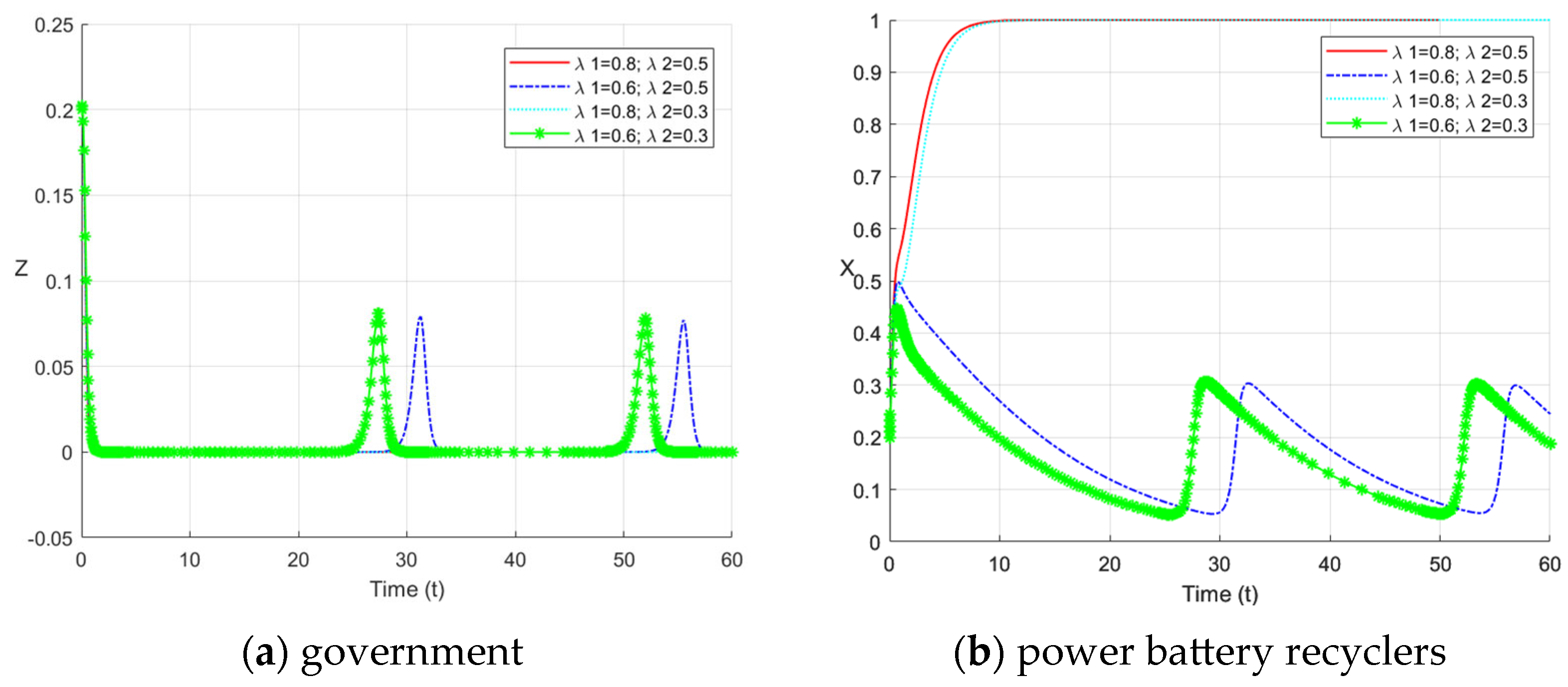1. Introduction
With the intensifying challenges of global climate change and energy shortages, the green transformation of the automotive industry has become a strategic priority for national energy security and sustainable development. Due to their significant advantages in energy conservation and emissions reduction, new energy vehicles (NEVs) are gradually becoming an important development direction for the global automotive industry. Since 2014, China has vigorously promoted the large-scale development of NEVs, resulting in a rapid increase in market penetration [
1]. By 2023, China’s NEV production and sales reached 9.5728 million and 9.4812 million units, respectively, representing year-on-year growth rates of 36.16% and 38.25%. This marks the ninth consecutive year China has ranked first globally, establishing the country as the world’s largest producer and consumer of NEVs [
2].
In the new energy vehicle (NEV) industry chain, power batteries are not only a core component, but also play a critical role in cost control and environmental performance. Currently, the commonly used power battery types include nickel–cadmium batteries, nickel–metal hydride batteries, lead–acid batteries, and lithium-ion batteries, among which lithium-ion batteries have gradually become dominant due to their high energy density and long cycle life [
3]. After retirement, these batteries can be subjected to either echelon utilization or resource recovery based on their remaining capacity. From the perspective of echelon utilization, power batteries are considered retired when their capacity falls below 80% of the original, making them unsuitable for vehicle use. Batteries with 20–80% remaining capacity can be repurposed for low-load applications, such as home energy storage systems, low-speed electric vehicles, and telecom base stations. Those with less than 20% capacity require dismantling and smelting to recover valuable metals and raw materials [
4].
It is estimated that by 2025, the cumulative volume of retired power batteries in China will reach 134.49 GWh. If not properly handled, this could result in the significant waste of critical metals such as nickel and cobalt [
5], as well as serious environmental pollution and safety risks due to toxic electrolytes and their high residual voltage [
6]. The traditional disposal methods, such as landfilling and incineration, pose substantial environmental hazards. In contrast, efficient recycling and reasonable echelon utilization not only support a closed-loop resource cycle, but also help reduce China’s reliance on imported raw materials for batteries [
7]. Therefore, establishing a standardized, efficient, and sustainable power battery recycling system has become a pressing issue for the continued development of the NEV industry.
To better understand the challenges facing power battery recycling, it is essential to review the current state of recycling system development. Major European countries have generally established closed-loop battery management systems centered on the Extended Producer Responsibility (EPR) principle, which requires battery manufacturers and vehicle producers to assume responsibility for the recycling and reuse of retired batteries. For example, Germany has implemented a nationwide recycling system through federal regulations, achieving a compliant recycling rate of over 85% for power batteries, while countries such as Norway and Sweden have surpassed 90% efficiency [
8].
In the United States, a combination of local legislation and market-based incentives has been adopted to promote the development of the recycling industry. Financial subsidies and a recycling credit system encourage businesses to engage in both the echelon utilization and resource recovery of retired batteries. However, coordination gaps and weaknesses in battery traceability in some states have led to uneven recycling performances. In Asia, Japan has established clear responsibilities for battery disposal through its Battery Recycling Act and adopted a centralized management system for highly polluting products. South Korea has focused on improving the efficiency of resource recovery technologies.
In contrast, China initially built a recycling network led by manufacturers and supported by regulatory platforms. A series of policy documents, such as the Interim Measures for the Administration of the Recycling and Utilization of New Energy Vehicle Power Batteries, were issued. Nevertheless, the overall system still faces challenges, including limited regulatory coverage, high technological costs, and poor participation from enterprises [
9,
10]. According to the incomplete statistics, the actual recycling rate of retired power batteries in China was below 50% in 2023. A portion of batteries entered the grey market through informal channels, posing significant environmental and resource risks [
11]. This situation highlights the urgent need to improve the coordination between incentives and constraints at the institutional level in order to guide stakeholders toward more efficient and compliant recycling behaviors [
12].
A review of the existing studies shows that the academic community has established a preliminary theoretical framework for power battery recycling mechanisms, covering various models, such as closed-loop supply chains, carbon incentive mechanisms, and deposit refund policies. However, most of these studies focus on bilateral game relationships or static optimization analyses, which fall short in capturing the behavioral evolution of enterprises, consumers, and governments under the conditions of incomplete information. In practice, recycling enterprises face trade-offs between cost and risk, consumers retain significant autonomy in battery usage, and governments operate with limited regulatory resources. The interactions among these three stakeholders are characterized by dynamic adjustments, bounded rationality, and strategic interdependence. Therefore, there is an urgent need to construct a dynamic game framework involving all three parties to systematically assess how different policy combinations influence behavioral evolution and system stability, thus providing a theoretical basis for institutional optimization.
Accordingly, this study focuses on the following three aspects:
- (1)
A tripartite evolutionary game model is developed to capture the interactions among recycling enterprises, consumers, and the government. Unlike the previous studies, this model incorporates the battery usage level of providers as a key factor in its formulation.
- (2)
Departing from the traditional single-factor analyses, this study employs numerical simulations to construct a dynamic evolutionary model. By setting multi-level combinations of government subsidies and penalties, it systematically quantifies the system’s evolutionary trajectory under varying policy intensities, offering precise quantitative insights for policy design. Moreover, this study moves beyond the conventional view of consumers as passive recipients, integrating complex consumer behavior patterns into the system evolution model. Through simulation, it reveals the impact of consumer behavior on system equilibrium and proposes evidence-based consumer guidance strategies, providing a novel approach for policy design and market regulation.
- (3)
This research not only enriches the theoretical understanding of power battery recycling, but also offers strong practical implications. By uncovering the conflicts of interest and cooperation mechanisms in the recycling process, it provides theoretical and practical support for governments to formulate sound recycling policies, for recycling enterprises to optimize their strategies, and for consumers to enhance their environmental awareness.
3. Model Assumptions and Parameters
3.1. Problem Description
With the worsening global climate crisis and energy shortages, the new energy vehicle (NEV) industry has become a key strategic pathway for countries aiming to achieve carbon neutrality.
Most existing studies focus on single stakeholders in power battery recycling—such as enterprises or governments—or rely on static economic models, lacking the systematic exploration of the dynamic game behaviors among multiple stakeholders. Given that the echelon utilization of power batteries involves strategic interactions among governments, recycling enterprises, and consumers—each exhibiting bounded rationality—this study adopts an evolutionary game model for analysis.
The model captures the dynamic interdependence among the three parties in terms of regulatory intensity, strategic choices, and usage behaviors. By employing replicator dynamic equations, it simulates the “trial-and-error–learning” process of strategy adjustment, overcoming the limitations of the traditional static models. This dynamic evolutionary perspective, combined with multi-parameter coupling analysis, not only reveals the system’s stable convergence states, but also provides theoretical and practical guidance for multi-stakeholder collaborative governance.
In response to the above issues, this study constructs a tripartite evolutionary game model involving the government, power battery recycling enterprises, and consumers, with a focus on addressing the following core conflicts:
The trade-off between economic and environmental considerations in power battery recycling enterprises’ strategy choices: Enterprises must seek an optimal strategy between echelon utilization (a low profit, but a high environmental value) and resource recovery (a high profit, but a low environmental value). Their decisions are significantly influenced by the consumer battery usage levels, government subsidy intensity, and the severity of punishments.
The conflict between short-term economic benefits and long-term sustainability in consumer battery usage behavior: Consumers tend to fully deplete batteries to reduce replacement costs. However, over-usage shortens the lifespan of batteries for echelon utilization, leading to resource wastage and increased environmental risks.
The contradiction between the incentive effects and implementation costs of government regulatory policies: The government needs to balance the subsidy inputs (economic incentives) and the severity of punishments (environmental constraints) to minimize regulatory costs, while maximizing social welfare.
By introducing consumer battery usage levels (λ1, λ2) as the key parameters and combining numerical simulation to analyze the impact of different initial strategies and policy parameters on the system’s evolutionary trajectory, this study aims to provide theoretical support for the collaborative optimization of the echelon utilization industry chain of power batteries. The research findings not only fill the theoretical gap in the interactive mechanisms among multiple stakeholders from a dynamic, theoretic game perspective, but also offer practical guidance for the government to formulate differentiated subsidy policies, recycling enterprises to optimize their recycling models, and consumers to enhance their environmental awareness. Ultimately, this study contributes to the efficient recycling and sustainable environmental development of power batteries throughout their entire life cycle.
3.2. Basic Assumptions and Parameters
Based on the relationship between the three players, the following hypothesis is proposed, and the relevant parameters are designed:
Assumption 1. The power battery recycling companies, the consumers, and the national market regulators represent participants 1, 2, and 3, respectively. All the participants have limited rationality and information asymmetry.
Assumption 2. The strategic space of power battery recycling enterprises includes priority echelon utilization and resource utilization. The probability of priority echelon utilization is expressed as x, and the probability of resource utilization is expressed as 1 − x, where x ∈ [0, 1]. Consumers’ strategic space includes two choices: appropriate use and total consumption. The probability of moderate utilization is expressed as y, and the probability of total consumption is expressed as 1 − y, where y ∈ [0, 1]. The strategic space of national market regulators consists of two choices: intense supervision and weak supervision. The probability of solid supervision is expressed as z, and the probability of weak supervision is expressed as 1 − z, where z ∈ [0, 1].
Assumption 3. The priority echelon utilization income of power battery recyclers includes echelon utilization income (R1) and resource utilization income (R2). The corresponding costs mainly include echelon utilization costs (C1), such as recovery system construction costs, operation and maintenance costs, collection costs, storage costs, and transportation costs; and other recovery costs, such as inspection, disassembly, and remanufacturing costs (C2). After enterprise testing, retired batteries with low echelon utilization value can be reused as resources. By multiplying the total echelon utilization profit and the total dismantling profit by the echelon utilization ratio (λ) minus the detection and classification cost (Ce), the total profit of the enterprise can be obtained as λ × (R1 − C1) + (1 − λ) × (R2 − C2) − Ce. For enterprises, the total profit of resource utilization is the difference between the income obtained from the resource utilization of batteries (R2) and the cost paid by the resource utilization of batteries (C2). C2 mainly includes the recovery cost, dismantling cost, and smelting cost, that is, R2 − C2.
Assumption 4. Different strategies chosen by enterprises will also impact the provider’s income, such as reducing battery price after echelon utilization, environmental improvement, and psychological benefits to meet consumers’ green consumption needs. The consumer benefit under priority echelon utilization is Rc1, the consumer benefit under resource utilization is Rc2, and the cost of providing batteries is V. The total payoff that can be obtained for the provider is Rc − V. According to the degree of use of consumers, when consumers use moderately, the battery echelon utilization rate is λ1; When the consumer is fully consumed, the battery echelon utilization rate is λ2. The current power battery recycling market is not mature, and there is an irregular market bidding to recycle batteries, resulting in the specific recovery price being affected by market supply and demand, battery quality, remaining life and performance, and other factors, and there is no precise pricing mechanism. Therefore, according to the current market pricing and development status of power battery recycling, it is assumed that Rc1 > Rc2, λ1 > λ2.
Assumption 5. When the government chooses a robust regulatory strategy, it will incur a regulatory cost C, give a subsidy K1 to the recycling enterprises that choose priority use, give a subsidy K2 to the consumers that choose moderate use, and give a penalty T to the enterprises that choose resource utilization. The green environment, public reputation, and carbon emission reduction benefits obtained by the government in establishing the echelon utilization and resource utilization industries are Rg1 and Rg2 (Rg1 > Rg2), respectively. The overuse of a battery will reduce the return to the original μx.
The parameters are summarized in
Table 1 below.
5. Simulation Analysis
Based on the theoretical derivation of the aforementioned model, this paper employs numerical analysis to verify the stable strategy of the equilibrium point E5(1, 1, 0) in the model. Meanwhile, the influences of different initial conditions, as well as the government’s rewards and punishments, are discussed to provide references for local governments in constructing the power battery recycling industry chain.
5.1. Analysis of System Evolutionary Trajectories
Based on the analysis of the above evolutionary game model, the equilibrium point E
5 (1, 1, 0) is considered under its stability conditions, as follows:
These conditions ensure both the stability and solvability of the model, allowing for the derivation of reasonable strategy evolution outcomes that reflect the behavioral characteristics of each stakeholder.
On this basis, and with reference to the parameter settings used in the studies by Guan et al. [
37] and Wang Wenbin et al. [
49], as well as practical factors such as the technical characteristics and service life of power batteries, the initial values for the parameters in the payoff matrix are estimated as shown in
Table 4.
By setting the initial strategy probabilities
x,
y, and
z for power battery recycling enterprises, consumers, and the government at 0.1, respectively, the evolutionary stable strategies for the three parties are obtained as shown in
Figure 4a. Despite the differing evolutionary rates of power battery recyclers and consumers, both ultimately tend towards cooperation, with consumers exhibiting the fastest evolutionary trend towards stability. Meanwhile, the government evolves towards a state of weak regulation.
To further analyze the impact of different initial strategies of the three entities on the overall evolutionary trajectory, the initial strategy probabilities
x,
y, and
z for local power battery recyclers, consumers, and the government are cyclically selected at intervals of 0.20 within the range [0, 1]. The overall evolutionary trajectories for the three parties are depicted in
Figure 4b, where each line represents the evolutionary path under different initial probabilities of
x,
y, and
z. Although the initial strategy probabilities vary among the lines, the evolutionary trajectories still satisfy the stability conditions, that is, the overall evolutionary stable strategy is E
7(1, 1, 0). This confirms the correctness of the aforementioned theoretical derivation.
5.2. The Impact of Initial Strategies on Evolutionary Stability
The initial strategy selection probabilities of two parties were fixed at 0.5 while the third party’s probability varied among 0.2, 0.5, and 0.8, generating nine datasets for each scenario. Specifically, when consumers and the government (
y and
z) were fixed, the effect of power battery recyclers’ (
x) initial strategy was analyzed (
Figure 5). When recyclers and government (
x and
z) were fixed, consumers’ (
y) impact was studied (
Figure 6). Lastly, with recyclers and consumers (
x and
y) fixed, the government’s (
z) influence was examined (
Figure 7). These analyses reveal the evolutionary outcomes of the three parties under different initial conditions.
As shown in
Figure 5, the initial choice probability of power battery recyclers significantly impacts the government’s evolutionary path. Regardless of whether the probability is low or high, the government’s regulatory strategy tends to evolve towards weak regulation. Moreover, as the initial probability of power battery recyclers increases, the government’s evolution accelerates. This indicates that when power battery recyclers actively engage in echelon utilization, the reduced environmental impact prompts local governments to weaken regulation more quickly. In contrast, consumers’ strategy choices are not significantly affected by the initial probability of power battery recyclers’ strategy selection, and they ultimately evolve towards moderate utilization.
As shown in
Figure 6, it is shown that the initial probability of consumers choosing moderate utilization can influence the strategy changes in power battery recycling enterprises, but the effect is relatively small. To be specific, regardless of whether consumers have a low or high initial probability of choosing moderate utilization, the strategy of power battery recycling enterprises will evolve towards prioritizing echelon utilization. Moreover, as the initial probability of consumers choosing moderate utilization increases, the evolutionary rate of power battery recycling enterprises’ strategy also increases. This is attributed to the fact that active moderate utilization by consumers can yield greater benefits for power battery recycling enterprises from the prioritized echelon utilization strategy. However, changes in consumers’ initial strategy selection probability have no significant impact on the government’s strategy choice; the government’s strategy will ultimately evolve towards weak regulation.
As shown in
Figure 7, the government’s initial strategy selection probability significantly influences the evolutionary trajectories of power battery recyclers and consumers, with a more pronounced effect observed on the recyclers. Specifically, regardless of whether the government’s initial probability is low or high, the strategies of power battery recyclers and consumers tend to evolve towards prioritized echelon utilization and moderate utilization, respectively. Moreover, as the government’s initial probability increases, the evolutionary rates of both power battery recyclers and consumers accelerate.
When the government’s initial probability of supporting or promoting echelon utilization of power batteries is low, recyclers may adopt a wait-and-see attitude, making limited initial investments due to uncertainty regarding future government support and the actual market demand. However, as the initial probability rises, recyclers immediately perceive strong policy signals and optimistic market prospects, prompting them to rapidly adjust their strategies. They increase recycling efforts and invest in technological innovation to gain a first-mover advantage in the market. In this scenario, the evolutionary rate of recyclers accelerates, driven by the dual forces of policy incentives and market demand.
Although consumers are less directly influenced by government policies, their behavior can still be shaped by policy initiatives. When the government actively promotes the echelon utilization of power batteries and publicizes its importance through various channels, consumers’ environmental awareness gradually strengthens, and their willingness to participate in echelon recycling activities increases. Consequently, as the government’s initial probability rises, the probability of consumers’ strategies evolving towards moderate utilization accelerates, indicating a greater inclination to participate in power battery recycling.
It is worth noting that the evolutionary rate of consumers may be slightly slower than that of recyclers. This is because changing consumer behavior typically requires a more extended period of education and guidance. However, once a social trend and a habit are established, consumer participation is expected to steadily increase.
5.3. Sensitivity Analysis
5.3.1. Impact of Punishment Intensity on Evolutionary Dynamics
To investigate the influence of punishment intensity on the evolutionary equilibrium of local governments and power battery recyclers, the punishment parameter
T in the regulatory strategy of local governments was varied, while keeping other parameters constant. This analysis was based on a benchmark value of
T = 15. Two scenarios were considered: a low-intensity case with
T = 15 and a high-intensity case with
T = 20. The evolutionary outcomes for the government and power battery recyclers are illustrated in
Figure 8.
Overall, the evolutionary trajectories of the government and power battery recyclers are influenced by the intensity of punishment. Irrespective of the level of punishment intensity, the government entity ultimately evolves towards weak regulation, while power battery recyclers consistently evolve towards prioritizing echelon utilization. However, as the punishment intensity increases, the evolutionary rate of recyclers accelerates. This indicates that higher punishment costs incentivize recyclers to prioritize echelon utilization strategies.
For the government, the evolutionary rate exhibits a non-linear pattern, initially decreasing, and then increasing. When the punishment intensity is low, the regulatory costs incurred by the government significantly exceed the revenue generated from punishments. This imbalance leads to insufficient regulatory intensity. As the punishment intensity increases, the gap between regulatory costs and punishment revenue narrows. This allows the government to have more adequate funding to maintain its regulatory efforts. However, excessively high punishment costs can accelerate the strategy evolution of recyclers, leading to the quicker stabilization of the system. This, in turn, also accelerates the government’s transition to a weaker regulatory intensity.
5.3.2. Impact of Subsidy Intensity on Evolutionary Dynamics
To investigate the influence of subsidy intensity on the evolutionary equilibrium of power battery recyclers and consumers, the reward parameters
K1 and
K2 in the regulatory strategy of local governments were varied. This analysis was based on a benchmark scenario, where
K1 = 5 and
K2 = 2. Three scenarios were considered: a low-subsidy case with
K1 = 2 and
K2 = 1, a benchmark case, and a high-subsidy case with
K1 = 8 and
K2 = 5. The evolutionary outcomes for power battery recyclers and consumers are illustrated in
Figure 9.
As shown in
Figure 9a, the evolution rate of the probability of power battery recyclers adopting prioritized echelon utilization initially increases with the subsidy intensity, but eventually evolves in the opposite direction over time. This suggests that when the government implements a regulatory mechanism that combines punishment and subsidies, blindly increasing subsidies can be counterproductive and may actually impede the evolutionary speed of power battery recyclers.
Figure 9b indicates that although the convergence rate of consumer evolution is proportional to the subsidy intensity, the impact of subsidy intensity on consumer behavior is relatively minor.
5.3.3. Impact of Government’s Singular Regulatory Approach on the Evolution of Power Battery Recyclers
To comprehensively compare the effects of punishment and subsidy, as individual regulatory tools implemented by local governments, on the evolution of power battery recyclers, four distinct composite scenarios were designed and analyzed. These scenarios included the following: (1) a subsidy without punishment, (2) a high subsidy without punishment, (3) no subsidy with punishment, and (4) no subsidy with extreme punishment. The specific parameter settings for these scenarios were as follows: (1)
K1 = 5,
T = 0, (2)
K1 = 8,
T = 0, (3)
K1 = 0,
T = 15, and (4)
K1 = 0,
T = 18. The evolutionary strategies of power battery recyclers under these scenarios are illustrated in
Figure 10.
As shown in
Figure 10, when local governments employ either a punishment or subsidy alone without adjusting the intensity of the strategy, power battery recyclers tend to choose the strategy of prioritizing echelon utilization. However, recyclers exhibit different sensitivities to subsidies and punishments. An increase in either subsidy or punishment intensity accelerates the evolution of recyclers towards prioritizing echelon utilization. Compared to subsidies, recyclers are more sensitive to punishment. To avoid punishment, recyclers are more likely to accelerate their transformation into echelon utilization enterprises.
Overall, when the government adopts a singular regulatory approach, a strategy of “no subsidy with high punishment” can be effective. This approach can achieve system stabilization at a lower cost by leveraging the higher sensitivity of recyclers to punishment.
5.3.4. Impact of Power Battery Utilization Level on Evolutionary Dynamics
To comprehensively compare the effects of consumer battery utilization intensity on the evolutionary strategies of governments and power battery recyclers, four distinct composite scenarios with varying levels of moderate and intensive utilization and echelon utilization recycling rates were designed. The specific parameter settings for these scenarios were as follows: (1)
λ1 = 0.8,
λ2 = 0.5, (2)
λ1 = 0.6,
λ2 = 0.5, (3)
λ1 = 0.8,
λ2 = 0.3, and (4)
λ1 = 0.6,
λ2 = 0.3. The evolutionary strategies of power battery recyclers and governments under these scenarios are illustrated in
Figure 11.
As shown in
Figure 11a, under high echelon utilization recycling rates, the government gradually withdraws from the market, allowing for battery recycling to be driven by market competition. This approach not only reduces the government regulatory costs, but also enhances corporate resource allocation efficiency and innovation capabilities through competition, ultimately leading to more reasonable returns for consumers. However, the long-term overuse of power batteries reduces the echelon utilization recycling rate. The extensive resource-based recycling of batteries leads to resource wastage and environmental pollution, prompting the government to increase the regulatory intensity.
For power battery recyclers, as shown in
Figure 11b, a higher echelon utilization rate results in higher corporate profits, incentivizing them to strengthen echelon recycling efforts. When consumers overuse batteries, the profits from echelon utilization decrease, causing recyclers to gradually shift their strategies towards resource-based recycling. In response, the government suddenly increases the regulatory intensity. To comply, power battery recyclers enhance echelon utilization. However, when the government gradually reduces regulatory intensity, recyclers revert to resource-based recycling, leading to fluctuations in their strategies and less willingness.
In summary, overuse by consumers not only fails to provide reasonable returns for consumers, but also prevents the market from forming a spontaneous green recycling loop, resulting in significant resource wastage.
6. Conclusions and Policy Recommendations
6.1. Conclusions
This study constructs an evolutionary game model involving the government, power battery recycling enterprises, and consumers to analyze their strategic interactions and dynamic evolution in the echelon utilization of retired power batteries from new energy vehicles. The findings highlight the strong interdependence among stakeholders, shaped by government regulation and incentive policies. The main conclusions are as follows:
Recycling enterprises tend to prioritize echelon utilization over direct resource recovery to better align with environmental objectives, despite potentially lower economic returns. Proper government subsidies encourage this shift, especially when consumers adopt moderate battery usage, thereby improving the overall utilization rates and reducing the environmental impact.
Consumer behavior is critical to echelon utilization efficiency. Moderate usage prolongs battery life and increases reuse potential, whereas overuse accelerates degradation and environmental risks. Enhancing public awareness and promoting sustainable usage are therefore essential.
The government’s role is vital in designing effective incentives and penalties. Sensitivity analysis identifies the key policy thresholds: Subsidies (K1) above five and penalties (T) above fifteen markedly speed up enterprises’ transition toward echelon utilization. Consumer subsidies (K2) exceeding two significantly boost participation. Recycling firms are more responsive to penalties than subsidies, supporting a “low-subsidy, high-penalty” policy for rapid and cost-effective market transformation.
Policy implementation should proceed in phases: the short-term enforcement of scrapping regulations with basic incentives; a medium-term focus on technological R&D to enhance utilization efficiency; and long-term dynamic policy adjustment alongside consumer education to foster environmental responsibility.
While consumer behavior evolves more gradually, growing environmental awareness and social norms will drive increased participation, reinforcing echelon utilization adoption.
This study acknowledges its limitations. The parameter assumptions reflect the current market and technology conditions and may shift with future developments; the model focuses on the government, enterprises, and consumers, excluding other stakeholders; and it assumes bounded rationality, not fully capturing complex behavioral factors. These limitations introduce avenues for future research.
6.2. Policy Recommendations
Based on the construction of the tripartite evolutionary game model involving the government, recycling enterprises, and consumers, as well as the simulation analysis results, this study proposes the following four policy recommendations from a life cycle management perspective to promote the standardized and efficient development of the power battery recycling and echelon utilization system.
First, a mandatory retirement system for power batteries should be established and improved as soon as possible, with clear standards for battery retirement and defined responsibilities for recycling. The simulation results indicate that in the absence of strict regulatory enforcement, recycling enterprises—lacking information on the residual value of batteries—tend to favor direct material recovery due to cost and risk considerations, thereby limiting the potential for echelon utilization. It is therefore recommended that retirement be mandated when the remaining capacity of a battery falls below 80% or its usage exceeds a specified lifespan (e.g., eight years). A full life cycle traceability platform should be implemented to close the information loop from production and use to recycling. At the same time, market supervision should be strengthened by imposing administrative penalties on the enterprises and the vehicle owners who fail to properly dispose of retired batteries. This would help eliminate informal circulation channels, ensure that batteries are effectively routed into compliant recycling networks, and enhance both system controllability and resource utilization efficiency.
Second, based on the sensitivity analysis results, the incentive and penalty mechanisms in the recycling process should be optimized to form a more behaviorally effective policy toolkit. Specifically, numerical simulations reveal that enterprises are significantly more responsive to penalties than to subsidies. Therefore, a “low-subsidy, high-penalty” strategy is recommended to achieve stronger behavioral guidance at a lower fiscal cost. On this basis, it is advised that the ratio between the penalty for prioritizing direct recycling (T) and the subsidy for choosing echelon utilization (K1) should not be lower than 1.5, in order to establish a sufficiently strong deterrent. Additionally, a green credit rating system for enterprises could be introduced to strengthen their long-term commitment to green transformation. Through this combined incentive structure, enterprise strategies can be effectively guided toward stable convergence in favor of echelon utilization, thereby enhancing the overall sustainability of the industry.
Third, at the consumer level, greater emphasis should be placed on their behavioral role in guiding the echelon utilization of power batteries. Specifically, efforts should be made to enhance consumer motivation for moderate battery use and environmental awareness. The game model analysis indicates that consumer usage behavior directly affects the value of echelon recycling; frequent deep discharges significantly reduce the battery’s residual value and compatibility for second-life applications, whereas moderate use helps extend the battery’s lifespan and improve recovery efficiency. Therefore, it is recommended to establish a green usage incentive mechanism targeting consumers. By leveraging battery condition monitoring data, users who consistently maintain good charging and discharging habits can receive monetary rewards or points-based incentives. Platforms can also provide timely notifications to guide consumers in choosing optimal battery replacement timing. Moreover, for users who voluntarily return retired batteries after moderate use, a subsidy of K2 ∈[2, 3] can be provided to create a positive feedback loop of “environmental behavior–economic reward.” The goal is to increase the proportion of consumers practicing moderate battery use to over 65%, thereby fostering a mutually reinforcing green behavior system between consumers and recycling enterprises.
Finally, to ensure cost-effective and technically feasible echelon utilization, it is essential to accelerate the development and deployment of key technologies and supporting infrastructure. The simulation results show that when detection and dismantling costs are too high (e.g., Ce ≥ 0.5 and C1 ≥ 3), enterprises tend to favor direct material recovery, undermining the economic viability of echelon utilization. Thus, priority should be given to advancing critical technologies in the echelon process—such as rapid residual value detection, standardized module reassembly, and optimized non-destructive dismantling techniques—to improve processing efficiency and enhance the accuracy of second-life battery matching. In parallel, industry alliances should be formed to promote unified testing standards and traceability platform development, thereby reducing the information screening costs and decision risks for recycling enterprises. The target is to reduce Ce to below 0.3 and keep C1 under 2.5, thereby enhancing the cost advantage of echelon utilization and improving the market feasibility of the technical pathways.
In conclusion, building an efficient power battery recycling and echelon utilization system requires coordinated efforts from governments, enterprises, and consumers. By integrating behavioral mechanism design, technological and economic support, and institutional development, a closed-loop and stable green recycling network can be formed. The policy recommendations proposed in this study—grounded in the evolutionary game theory and numerical simulation—offer both theoretical rigor and practical feasibility, providing strong support for the sustainable development of power batteries in China’s new energy vehicle sector.
6.3. Model Limitations and Future Research Directions
While the tripartite evolutionary game model developed in this study effectively reveals the strategic evolution patterns in the echelon utilization of power batteries, several limitations remain.
Limitations in Empirical Validation:
The model parameters (e.g.,
λ1,
λ2, and
K1) were primarily derived from the literature data and the industry standards (see
Section 5.1). Although sensitivity analysis confirmed the robustness of these parameters (see
Section 5.3.4), the model lacks empirical calibration using large-scale data on retired batteries (e.g., the distribution of echelon utilization rates under different usage conditions) and actual enterprise-level cost data. Future research could integrate real-world recycling data from firms such as CATL and GEM to develop machine learning models for improved parameter accuracy.
Impact of Simplified Strategy Space:
Consumer behavior in the model is simplified into a binary choice between “moderate use” and “full consumption,” without considering intermediate strategies such as “partial consumption” and “wait-and-see.” Similarly, government regulation is modeled only as “strong” or “weak,” omitting continuous variations in regulatory intensity (e.g., inspection frequency and enforcement strength). While such simplifications facilitate theoretical modeling, they may overlook the influence of more nuanced behavioral patterns on system dynamics. Future studies could apply the fuzzy game theory or differential game approaches to expand the strategic space.
Boundaries of the Bounded Rationality Assumption:
The model assumes that all three stakeholders adjust their strategies through a “trial-and-error learning” process. However, in reality, enterprises may possess more sophisticated forecasting abilities—such as anticipating policy shifts—while consumer decisions may also be shaped by social norms, brand trust, and other non-economic factors. Incorporating concepts from behavioral economics—such as social preferences and cognitive biases—into future models could help enhance the realism of the decision-making mechanisms.
Neglect of Regional Development Disparities in China:
The current model does not explicitly account for significant regional differences across China in terms of infrastructure, economic development, and policy enforcement capacity. For example, the eastern regions have begun to form industrial clusters with large-scale echelon utilization capabilities, whereas the central and western regions face challenges such as sparse recycling networks, high logistics costs, and weak policy enforcement. As a result, the effectiveness of uniform national policies may vary significantly by region. Future research could incorporate regional heterogeneity parameters into the model and construct stratified regional game models to explore differentiated policy responses and co-evolutionary pathways, thereby offering decision support for the region-specific implementation of national echelon utilization strategies.
